Efficacy of Paroxetine in the Treatment of Adolescent Major Depression: A Randomized, Controlled Trial
by MARTIN B. KELLER, M.D., NEAL D. RYAN, M.D., MICHAEL STROBER, PH.D., RACHEL G. KLEIN, PH.D., STAN P. KUTCHER, M.D., BORIS BIRMAHER, M.D., OWEN R. HAGINO, M.D., HAROLD KOPLEWICZ, M.D., GABRIELLE A. CARLSON, M.D., GREGORY N. CLARKE, PH.D., GRAHAM J. EMSLIE, M.D., DAVID FEINBERG, M.D., BARBARA GELLER, M.D., VIVEK KUSUMAKAR, M.D., GEORGE PAPATHEODOROU, M.D., WILLIAM H. SACK, M.D., MICHAEL SWEENEY, PH.D., KAREN DINEEN WAGNER, M.D., PH.D., ELIZABETH B. WELLER, M.D., NANCY C. WINTERS, M.D., ROSEMARY OAKES, M.S., AND JAMES P. MCCAFFERTY, B.S.
Journal of the American Academy of Child and Adolescent Psychiatry, 2001, 40(7):762–772.
Abstract
Objective: To compare paroxetine with placebo and imipramine with placebo for the treatment of adolescent depression.
Method: After a 7 to 14-day screening period, 275 adolescents with major depression began 8 weeks of double-blind paroxetine [20–40 mg], imipramine [gradual upward titration to 200–300 mg], or placebo. The two primary outcome measures were endpoint response [Hamilton Rating Scale for Depression [HAM-D] score <8 or >50% reduction in baseline HAM-D] and change from baseline HAM-D score. Other depression-related variables were [1] HAM-D depressed mood item; [2] depression item of the Schedule for Affective Disorders and Schizophrenia for Adolescents-Lifetime version [K-SADS-L]; [3] Clinical Global Impression [CGI] improvement scores of 1 or 2; [4] nine-item depression subscale of K-SADS-L; and [5] mean CGI improvement scores.
Results: Paroxetine demonstrated significantly greater improvement compared with placebo in HAM-D total score <8, HAM-D depressed mood item, K-SADS-L depressed mood item, and CGI score of 1 or 2. The response to imipramine was not significantly different from placebo for any measure. Neither paroxetine nor imipramine differed significantly from placebo on parent- or self-rating measures. Withdrawal rates for adverse effects were 9.7% and 6.9% for paroxetine and placebo, respectively. Of 31.5% of subjects stopping imipramine therapy because of adverse effects, nearly one third did so because of adverse cardiovascular effects.
Conclusions: Paroxetine is generally well tolerated and effective for major depression in adolescents.
The criticisms of the article are now legendary and need not be detailed – they cover every aspect of the process that lead to the publication of this paper with twenty-two named authors [and at least one unnamed, the person that actually wrote it – Sally Laden]. But there’s one criticism I haven’t run across people talking about – this is simply not possible:
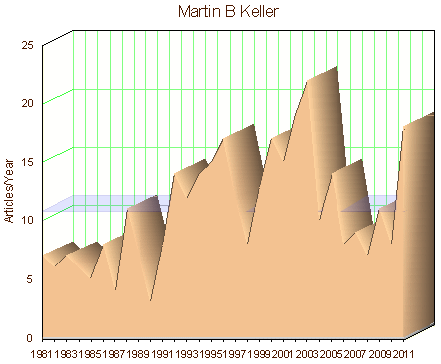
That’s a
10.8 Articles/Year average sustained for
thirty years. For twenty of those years, he was Chairman of Psychiatry at Brown, along with many other committees and duties [
curriculum vitae]. Maybe some of us can hack out blog posts pretty fast, or reporters can bang out newspaper articles daily, or baseball players can play every night for a season for a few years – but there is no person who can produce a meaningful scholarly article every month for thirty years, not even in collaboration with others. And these articles Keller writes require studies involving a lot of people etc. But independent of the logistics, creative and analytic thought just can’t run at that speed – even in
herds. So how does one do that? [references from
Healthy Skepticism]:
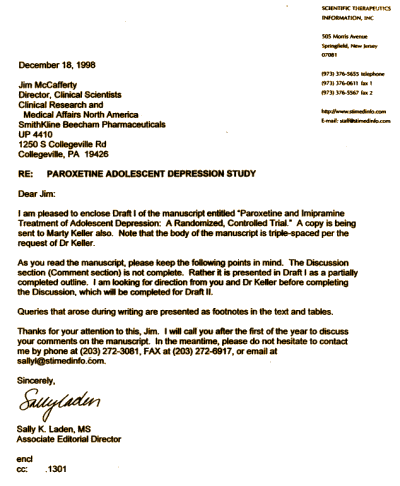
You hire it out is how you do that. Notice that Sally Laden, the author is sending the letter about her manuscript to Jim McCafferty, Director of Clinical Scientists at SmithKline Beecham Pharmaceuticals, and she sent a copy to Marty Keller too – the published first author. Note also that JAMES P. MCCAFERTY is listed as the last author on the paper.
I read Marty‘s response as asking author Sally to check with all the other guest authors about revisions and get it ready for submission quickly. But things didn’t work out so well. JAMA turned it down, so they submitted it to the Journal of the American Academy of Child and Adolescent Psychiatry where it bounced back and forth a few times. In this later email train, Marty‘s getting impatient and SmithKline Beecham appears to be getting cold feet [read bottom up]:
So time passed, and the ill-fated Study 329 was finally published by Mina Dulcan, Editor of American Academy of Child and Adolescent Psychiatry at the time [see
retract study 329… for further comments about Drs. Dulcan and Keller]. These later internal emails from SmithKline Beecham say it all – "
the study did not really show Paxil was effective in treating adolescent depression, which is not something we want to publicize" [read bottom up]:
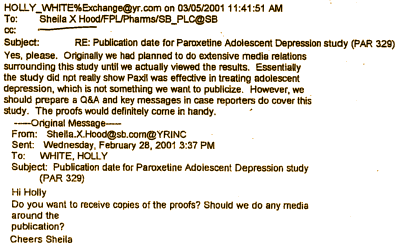
So, back to the point,
another point. If you read this blog often, you may notice that I sometimes compile graphs like that one of Keller’s Articles/Year. It’s kind of a hobby I’ve picked up. I did one on Dr. John Rush this week [
for real…]. Here’s one on Dr. Joseph Biederman [
bipolar kids: not someone to jerk around…]. Here’s yet another on the yield from STAR*D [
infectious numerology…]. I do them because I think that anybody publishing that many articles is into something crazy – something I don’t really understand [except that it’s crazy]. The first time I ever saw such a thing was when Dr. Nemeroff was being looked at for Chairman at Emory in the late 1980s, and they sent around his résumé. By that time, I was in practice, and my partners and I sat around at lunch one day giggling about it, wondering what it meant to have published that many articles, been in that many "clubs." Our conclusion? It wasn’t possible for such a thing to be legit [and it wasn’t, as it turned out].
I know a number of real scholars, people who are well-placed in academic positions in Universities on the faculties in the Arts and Sciences, and I know that they spend a lot of their life on their scholarship Рand they publish when they have something to say [or need a promotion]. An article a month? An article a week? Totally absurd! Unheard of. Who would see that as sensible? Who would want someone as chairman who did that [apparently Emory, Brown, Harvard, etc]? It still seems absurd to me, but at least in post-1980s academic psychiatry, it has apparently been desirable and lots of people are doing it. It feels downright Freudian to me ["My r̩sum̩ is longer than your r̩sum̩!"].
 My point [the another point] is that PHARMA took advantage of whatever craziness super-publishing is all about and made it easy. Instead of graduate students writing all the articles, PHARMA would manage the study [or hire it out], provide the writer from a paid medical writing firm, manage all the communications with the Journals and Editors, and pay you to be on an advisory board to boot [maybe even gave your program "unrestricted" educational grants] – one-stop shopping. Reminds me of a line from an old Dire Straights’ song, "Money for nothing, and the chicks are free."
My point [the another point] is that PHARMA took advantage of whatever craziness super-publishing is all about and made it easy. Instead of graduate students writing all the articles, PHARMA would manage the study [or hire it out], provide the writer from a paid medical writing firm, manage all the communications with the Journals and Editors, and pay you to be on an advisory board to boot [maybe even gave your program "unrestricted" educational grants] – one-stop shopping. Reminds me of a line from an old Dire Straights’ song, "Money for nothing, and the chicks are free."
The furor about Keller’s Study 329 didn’t slow him down a bit. He stayed on as Chairman at Brown until 2009, and the articles kept coming, even to the present. So the another point is that people with article counts in the hundreds have to be looked at with a "healthy skepticism" [to borrow a term]. It’s just not possible that résumés that look like his, or Rush’s, or Biederman’s, or Nemeroff’s, etc represent true scholarship, or even something remotely good. And Brown University would do well to think about the fact that it’s their future prestige that Dr. Keller and the Companies funding and otherwise supporting his studies are preying on. Beyond that, résumé churning of this magnitude is a sure sign that something is very, very wrong…



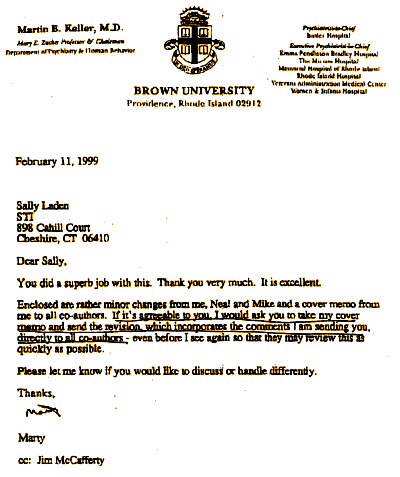
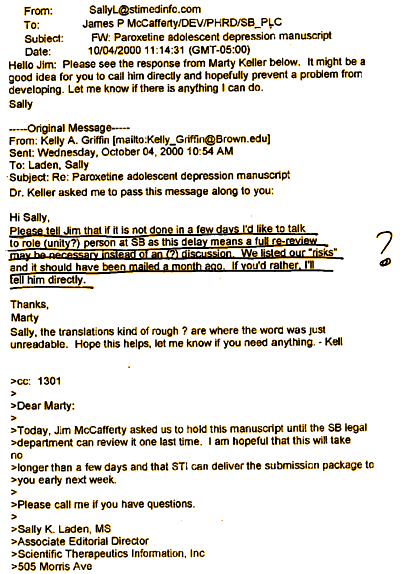

 My point [the another point] is that PHARMA took advantage of whatever craziness super-publishing is all about and made it easy. Instead of graduate students writing all the articles, PHARMA would manage the study [or hire it out], provide the writer from a paid medical writing firm, manage all the communications with the Journals and Editors, and pay you to be on an advisory board to boot [maybe even gave your program "unrestricted" educational grants] – one-stop shopping. Reminds me of a line from an old Dire Straights’ song, "Money for nothing, and the chicks are free."
My point [the another point] is that PHARMA took advantage of whatever craziness super-publishing is all about and made it easy. Instead of graduate students writing all the articles, PHARMA would manage the study [or hire it out], provide the writer from a paid medical writing firm, manage all the communications with the Journals and Editors, and pay you to be on an advisory board to boot [maybe even gave your program "unrestricted" educational grants] – one-stop shopping. Reminds me of a line from an old Dire Straights’ song, "Money for nothing, and the chicks are free."
Dear Doctor ~ I am Ginger Breggin Peter Breggin MD’s wife — and we are delighted to see the work you have been doing in analyzing and covering the details of the Psychopharmaceutical Complex world and influence. Thank you! We would love to speak with you. If you are able, please email me at the email provided. Very best regards, Ginger Breggin
File under “My resume is longer than your resume!”:
http://psycnet.apa.org/psycinfo/2005-12120-001
Maurizio Fava, Director, MGH Clinical Trials Network and Institute, and Slater Family Professor of Psychiatry at Harvard Medical School:
About the MGH Clinical Trials Network and Institute http://www.massgeneral.org/research/researchlab.aspx?id=1133 : “(over $35 million in research programs last year)….The MGH Psychiatry CTNI offers industry sponsors access to a broad range of state-of-the- art services, including the most advanced technology and methodology.”
Listed as an author of about 600 papers in 36 years, an average of 16 per year. First author on 132 of them, last author on around 200. Proponent of adjunctive medications and a member of the STAR*D paper mill (81 papers). 90 coauthored with John Rush, 98 with Nierenberg, 102 with Trivedi.
Member (with Schatzberg) of the antidepressant discontinuation syndrome expert consensus panel, sponsored by Lilly in 1997 and in 2004-2006, Wyeth. All we know of antidepressant withdrawal syndrome comes from these experts.
Around the office, known as “Moneybags.”